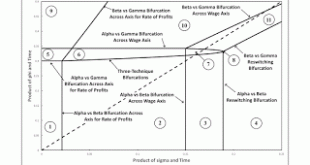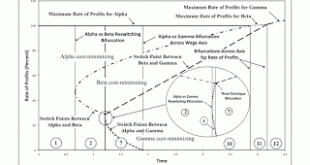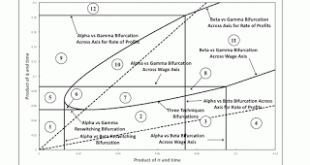This post, as suggested, extends this one-good example. I assume a constant returns-to-scale technology, as specified in Tables 1 and 2. Labor is advanced to the capitalists, and wages are paid out of the surplus at the end of the year (period of production). The capitalists (incorrectly) expect the technology in existence at the start of the year to continue to exist. I assume prices of (re)production prevail. Table 1: Inputs for The Technology InputProcess(I)(II)(III)Labor30 eσ0,1(1 -...
Read More »Structural Economic Dynamics with a Choice of Technique in General
Many - not all - of my recent numerical examples have a certain abstract pattern: At the start of the time under consideration, one technique is uniquely cost minimizing, for all feasible rates of profits. Coefficients of production decline or some markups over the normal rate of profits vary. A fluke switch point appears. Switch points move along the wage frontier, and interesting phenomena occur. These can be other fluke switch points. Reswitching, the recurrence of techniques,...
Read More »Update To A Start On A Catalog Of Switch Point Patterns Of High Co-Dimension
I have been looking at patterns of switch points. A pattern is a configuration of switch points helpful for perturbation analysis for the choice of technique. I am curious how the switch points and the wage curves along the wage frontier can alter with parameters, in a model of the production of commodities. Such a parameter can be a coefficient of production; time, where a number of parameters are functions of time; or the markup in an industry or a number of industries. A normal form...
Read More »Start of a Catalogue of Flukes of Fluke Switch Points
I claim that the pattern analysis I have defined can be used to generate additional fluke switch points. I am particularly interested in switch points that are flukes in more than one way (local patterns of co-dimension higher than one) and fluke switch points that are combined with other fluke switch points or some aspect of other switch points (global patterns). I have already generated some examples, not always with pattern analysis. Fluke switch points of higher co-dimension A switch...
Read More »Bifurcation Analysis of a Two-Commodity, Three-Technique Technology
Figure 1: A Bifurcation Diagram This post expands on this previous post. The technology is the same, but the rates of decrease of the coefficients of production in the Beta and Gamma corn-producing processes are not fixed. Instead, I consider the full range of parameter values. (I find the graphs produced by bifurcation analysis interesting for this case, but I think a two-commodity example can be found with more pleasing diagrams.) Anyways, Figure 1 shows a bifurcation diagram for the...
Read More »Reswitching Without a Reswitching Bifurcation
Figure 1: A Bifurcation Diagram This post presents another example of bifurcation analysis applied to structural economic dynamics with a choice of technique. This example illustrates: Two reswitching examples appear and disappear without a restitching bifurcation ever occurring, at least on the wage frontier. Two bifurcations over the wage axis arise. At the time each bifurcation of this type occurs, another switch point for the same techniques exhibits a real Wicksell effect of zero....
Read More »Bifurcation Analysis Applied to Structural Economic Dynamics with a Choice of Technique
Variation of Switch Points with Technical Progress in Two Industries I have a new working paper - basically an update of one I have previously described. Abstract: This article illustrates the application of bifurcation analysis to structural economic dynamics with a choice of technique. A numerical example of the Samuelson-Garegnani model is presented in which technical progress is introduced. Examples of temporal paths through the parameter space illustrate variations of the wage...
Read More »Structural Economic Dynamics with a Choice of Technique: A Numerical Example
A Bifurcation Diagram with Two Temporal Paths I have a working paper with the post title. Here's the abstract: This article illustrates the application of bifurcation analysis to structural economic dynamics with a choice of technique. A numerical example of the Samuelson-Garegnani model is presented in which technical change is introduced. Examples of temporal paths through the parameter space illustrate variations of the wage frontier. A single technique is initially uniquely...
Read More »Generic Bifurcations and Switch Points
This post states a mathematical conjecture. Consider a model of prices of production in which a choice of technique exists. The parameters of model consist of coefficients of production for each technique and given ratios for the rates of profits among industries. The choice of technique can be analyzed based on wage curves. A point that lies simultaneously on the outer envelope of all wage curves and the wage curves for two techniques (for non-negative wages and rates of profits not...
Read More »Bifurcations And Switchpoints
I have organized a series of my posts together into a working paper, titled Bifurcations and Switch Points. Here is the abstract: This article analyzes structural instabilities, in a model of prices of production, associated with variations in coefficients of production, in industrial organization, and in the steady-state rate of growth. Numerical examples are provided, with illustrations, demonstrating that technological improvements or the creation of differential rates of profits can...
Read More » Heterodox
Heterodox





